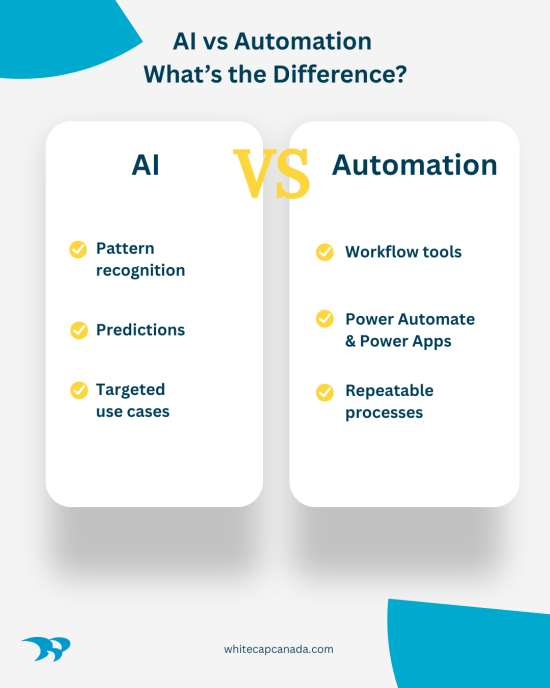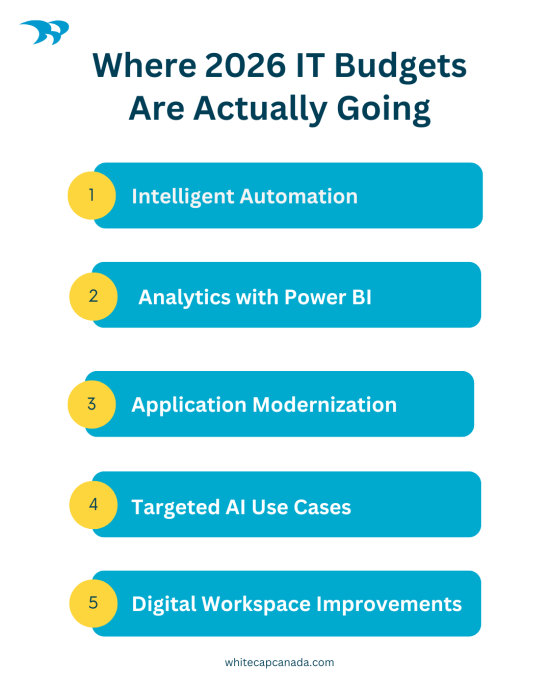|
Getting your Trinity Audio player ready...
|
As we inch closer to the new year, Canadian companies are keeping a close watch on their 2026 IT budgets. Many are holding steady on spending, with only minor increases. This tighter grip on the purse strings has another side effect: if it doesn’t deliver value, it doesn’t make the cut.
Let’s dig into some insights we’ve gleaned while looking at what’s happening in the IT space and from talking to clients.
Flatter 2026 IT Budgets, Higher Scrutiny
Gartner reports that more than half of Canadian organizations will see flat or modest IT budget increases of around 2% in 2026. This new austerity is a far cry from the growth rates seen just a few years ago. The result is that now the emphasis is on being more efficient, using automation to boost human productivity, and updating things strategically.
Technologies like AI and low-code development are advancing almost daily, and the fear of missing out is real. No one wants to be left behind. The challenge is separating genuine opportunity from hype, choosing smart investments today that let you scale and stay ready for what’s next.
Despite entering “the Trough of Disillusionment,” AI remains a hot topic. Yet to ensure they can show ROI, mid-market leaders are now eyeballing tools that deliver operational gains. These include workflow automation, data integration, analytics dashboards, and Microsoft-stack modernization projects that slash manual work and streamline decision-making.
In other words, 2026 won’t be about hype. It will be about proof.
 The Perception Problem
The Perception Problem
Many companies still treat AI and custom software as optional upgrades – projects to explore “when there’s room in the budget.” But that way of thinking ignores how central these technologies have become to compliance, competitive differentiation and getting things done.
One major misconception is that automation and AI are the same thing. They’re not. In the mid-market particularly, most measurable ROI still comes from automation. That means turning repetitive, labour-intensive processes into streamlined digital workflows using Power Automate, Power Apps, and other low-code tools. AI can certainly add value, but only when it’s aimed at a specific, high-volume problem.
Another sticking point is cost. When people hear “custom software,” they often think it just means a bigger price tag. In reality, it’s the kind of investment that pays off over time by reducing rework, speeding up delivery, and improving overall accuracy.
The question they need to ask themselves shouldn’t be “Can we afford it?” but rather “What does it cost us NOT to modernize?”
Pro Tip: Check out the questions execs and IT leaders should be asking.
Custom Software as a Strategic Asset
Custom software often gets labelled as a “nice-to-have,” yet it’s one of the most powerful ways to build durable business value. Working the way you do, it matches how your organization actually operates, and scales alongside you.
Unlike off-the-shelf SaaS tools, custom applications aren’t generic. They are designed around your workflows, not someone else’s. Custom software can reduce dependency on licenses, minimize workarounds, and get rid of those organizational silos that slow teams down. Modernized systems also extend the life of existing technology investments, protecting organizations from costly downtime or tech debt.
Cost is one of the biggest hurdles IT leaders face when pitching modernization projects and other tech investments, like custom software. Many buyers underestimate scope, expecting to spend $20,000 when a realistic project may range between $80,000 and $300,000.
The key is reframing the conversation. Custom software isn’t just an expense, it’s a business asset that appreciates and directly supports growth. (See what to expect during the custom software process.)
When building a business case, leaders should focus on metrics that matter:
- Time saved: Hours reclaimed each week through automation.
- Error reduction: Fewer manual mistakes and rework.
- Cycle-time compression: Faster delivery or reporting.
- Experience improvements: Better customer and employee satisfaction.
That’s the data finance teams want to see. Not vanity metrics or nebulous “digital transformation” goals.
Pro Tip: See six key considerations when choosing between custom software and SaaS.
The Canadian-Built Advantage
Another emerging trend shaping 2026 IT budgets is a growing “buy Canadian” preference. There has been a swing towards opting for Canadian software vendors, particularly when projects involve sensitive data or regulated industries.
Beyond compliance, local delivery has practical advantages: shared culture and language, clearer communication, and easier collaboration. Canadian-built software also ensures data sovereignty, keeping information under Canadian jurisdiction and away from foreign access risks.
For many organizations, that’s becoming a non-negotiable factor in vendor selection.
Pro Tip: Explore how Canadian-built custom software reduces risk.
AI in the Real World
AI is maturing, but it’s not the solution to every problem. The most successful organizations are using it in targeted, measurable ways rather than chasing broad transformation.
A few tangible, ROI-producing use cases include AI-powered chatbots or phone bots which are helping reduce call volumes by handling simple, common inquiries. In analytics, AI is improving predictive insights inside tools such as Microsoft Fabric and Power BI, helping leaders forecast demand or identify risk sooner.
The solutions have been built on defined business problems, implemented in phases, and measured for results. For most mid-market organizations, that’s the sweet spot for AI.
Pro Tip: Discover how AI is also being used to ratchet up automation’s potential.
 Where the Money’s Going
Where the Money’s Going
The biggest areas of investment for 2026 are remarkably practical: intelligent automation, analytics through Power BI, application modernization, and digital workspace improvements (such as SharePoint and intranet rebuilds).
Even CRM integrations and Power Platform solutions are seeing renewed interest as organizations look to remove silos and achieve “a single source of truth.” AI isn’t disappearing from the agenda, but for most mid-sized companies, it’s being layered into existing systems rather than built as a standalone initiative.
Modernization, automation, and analytics are where budgets are headed because they deliver visible results, including better employee productivity, reduced costs, and improved operational resilience.
Pro Tip: Download our application modernization guide to map out your action plan.
A Practical Playbook for 2026
To make modernization and AI adoption successful, IT leaders can take a pragmatic, step-by-step approach:
- Start with a problem statement. Define what you’re solving for and what outcomes you expect.
- Quantify the gains. Estimate time saved, errors reduced, or revenue potential.
- Get stakeholder buy-in early. Support from both technical and business teams is crucial.
- Deliver in phases. Build, test, measure, repeat. Avoid the “boil the ocean” mentality.
- Choose the stack last. Select tools after understanding the problem, not before.
This disciplined approach keeps projects measurable, affordable, and directly aligned to business goals.
For 2026 and beyond, the smartest tech investments will be the ones that prove their worth every day. Custom software and AI, used thoughtfully, give organizations the flexibility and insight to adapt, grow, and stay competitive well beyond 2026.
Pro Tip: Discover how to create an AI roadmap here.
FAQ
Q: Is AI the fastest path to ROI?
A: Not usually. In the mid-market, automation and analytics deliver faster, more measurable gains. AI works best when applied to a specific, repetitive use case, such as automating customer inquiries or classifying data at scale.
Q: Why does custom software seem expensive?
A: Most organizations underestimate scope. Building software is asset creation—it eliminates manual work, reduces error rates, and improves throughput. The returns compound over time.
Q: How can we make the case to finance custom software?
A: Lead with numbers tied to business outcomes. Quantify hours saved, rework avoided, and cycle times shortened. In short, show measurable payback. (See how to build the case for custom software and get inspired by how one company reduced reporting time by 50%.)
Q: Should we buy off the shelf or build custom software?
A: SaaS tools are fine for standard processes, but they can limit flexibility or introduce security and compliance risks. Custom software scales with your business and preserves your intellectual property.
Q: Why prioritize Canadian-built software solutions?
A: Local development supports funding eligibility, cultural fit, and data sovereignty. It also ensures your project is built, hosted, and supported under Canadian law. (And, there are plenty of good reasons why US-based firms may want to opt for Canadian-built software too!)
Maximize Your 2026 IT Budget
As organizations finalize their 2026 IT budgets, one theme is emerging: transformation isn’t optional, but it must be accountable. Custom software and AI are no longer experimental, they’re strategic.
The difference lies in how they’re used. The winners in 2026 won’t be the ones who chase every new technology trend. They’ll be the ones who define clear problems, measure outcomes, and treat their technology investments as long-term business assets. Whitecap helps organizations do exactly that: modernize responsibly, automate intelligently, and operationalize AI where it counts. Let’s chat about your needs.